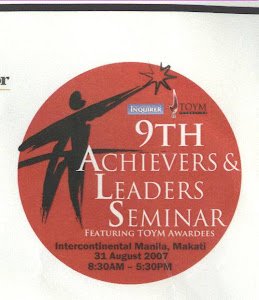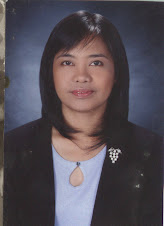The picture could be a person reaching for what looks like a star. But this is actually the logo used for a the "Achievers and Leaders" seminar. On that day I sat with bankers, journalists, academicians(who also asked for discounts like me), and business tycoons (wow!) that is to hear TOYM (Ten Outstanding Young Men) awardees to talk. There was Bo Sanchez (an inspirational speaker and writer), Maria Ressa (of Channel 2-you remember the Manila Pen issue?), Rico Hizon (of the BBC World), Louie Hernandez (of eTelecare who said that "Filipinos are not cheap. We are just better."), Vivienne Tan (daughter of the tycoon Lucio Tan), Dr. Raquel Fortun (of the Subic rape case), and Butch Jimenez (producer of Muro-Ami).
I didn't hear much about theories. Because there were really more to learn about their singular lives and stories. Here's 2 of those:
1. Bo related the story of 8 siblings who lost their parents. The father was supposedly an NPA and was killed and the mother succumbed to an illness. Left without parents the siblings lived in a mountain with the eldest gathering wood and selling this to buy them food.
Without other means to live the eldest had to scrimp using the matchstick she buys (sounds like the matchstick girl story) to cook their food. One day a neighbor asked for the last matchstick. The eldest to decided to give this after praying "Kayo na po'ng bahala sa amin." The same night they were found by Bo who eventually kept them in an orphanage. The eldest finally became a help in the orphanage by helping others also find a home.
Bo said that he did not pass either the UP, Ateneo or La Salle college exam. But he discovered that he was a good speaker and decided to use this - especially for those who needed conseling and prayer.
2. Dr. Fortun said that when she was little, she wanted to be different. So when she grew up she became a doctor among a family of lawyers. When deciding to go into medicine she said that she really did not have the patience to be with the patients. She would rather be with the dead "who could no longer speak about their death," and the maggots who looked like cheese.
She was schooled in poor UP and taught in poor UP. She would go wherever she was called. One time she was asked to exhume a kid who was killed because she was supposed to be an NPA. Another time she was in East Timor examining cadavers who were killed by goverment soldiers who did not want independence for East Timor. Another time she was cutting a cadaver on top of a door that was placed on a floor using, I think, kitchen knives.
Flashed on the screen, when she was almost through her talk, it showed "I need a job. Hire me."
Of course we laughed, in pain. Because there was really much to do and you could only measure your achievement in terms of emotional growth rather than monetary gain.
The lesson I learned (or re-learned)? That change is what we do, day in and day out, breath in and breath out.
Monday, December 10, 2007
Tuesday, December 4, 2007
Human Rights Violations
Since last week we've been hearing about statements like "from Manila Pen to National Pen", referring to the Trillanes group who staged a coup at the Manila Peninsula and ended up at the National Penitentiary after the bungled coup. There is also news about the journalists being gagged (again) for showing us, blow by blow, what happened at the Pen. The rebel soldiers are angry at the violations made by this incumbent government. The incumbent government wants to punish the journalist violators and the rebel soldiers. Sino ba ang violator?
Check this statistics which I got from a Sociology book - sorry I forgot the name of the author. But he cited a time (?)study on human rights violations and its perpetrators. Read below:
Sectoral Participation in Public Information Activities (1988-2000):
No. of participants
Government officials, employees - 99,282
Rebel returnees, prisoners - 11,379
Students, teachers, youth, school heads - 166,165
Military/ police - 165,018
Barrio residents, officials - 9,985
Religious sector - 1,409
Media - 1,307
Farmers/ fisherfolks - 726
Judiciary - 435
Urban poor - 4,629
NGO - 14,266
Rural/ urban industrial workers - 6,411
Professionals, civilian, general public - 83,545
Multi-sectoral - 228,339
Victims of HR violations (1988-June 2000):
Civilian - 8,374
Rural/ urban industrial workers - 5,189
child, women, student - 2,972
Military/ police - 759
Local officials/ employees - 507
Detainee/ prisoner - 330
Urban poor - 371
Others - 3,372
Alleged Perpetrators of HR Violations (1988-2000):
Police - 8,879
Military - 2,800
Para-military - 1,475
CPP-NPA - 2,298
Civilian - 3,129
Local officials, employees - 2,234
Others - 4,483
Are you surprised at the data? Seems like the more the military and the police attended info-dissemination activities, the more it was likely of them to be HR violators. We hope the trend is not institutionalized.
Check this statistics which I got from a Sociology book - sorry I forgot the name of the author. But he cited a time (?)study on human rights violations and its perpetrators. Read below:
Sectoral Participation in Public Information Activities (1988-2000):
No. of participants
Government officials, employees - 99,282
Rebel returnees, prisoners - 11,379
Students, teachers, youth, school heads - 166,165
Military/ police - 165,018
Barrio residents, officials - 9,985
Religious sector - 1,409
Media - 1,307
Farmers/ fisherfolks - 726
Judiciary - 435
Urban poor - 4,629
NGO - 14,266
Rural/ urban industrial workers - 6,411
Professionals, civilian, general public - 83,545
Multi-sectoral - 228,339
Victims of HR violations (1988-June 2000):
Civilian - 8,374
Rural/ urban industrial workers - 5,189
child, women, student - 2,972
Military/ police - 759
Local officials/ employees - 507
Detainee/ prisoner - 330
Urban poor - 371
Others - 3,372
Alleged Perpetrators of HR Violations (1988-2000):
Police - 8,879
Military - 2,800
Para-military - 1,475
CPP-NPA - 2,298
Civilian - 3,129
Local officials, employees - 2,234
Others - 4,483
Are you surprised at the data? Seems like the more the military and the police attended info-dissemination activities, the more it was likely of them to be HR violators. We hope the trend is not institutionalized.
Subscribe to:
Posts (Atom)
.jpg)

.jpg)